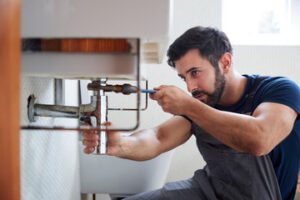Plumbers install and connect pipes, fixtures, appliances and other items used for water supply, waste removal and heating. They also interpret blueprints and building codes to plan plumbing projects and ensure compliance with local laws and regulations.

Many people start this career after completing high school or GED requirements and participating in an apprenticeship program. These programs last four to five years and include classroom instruction and paid on-the-job training.
A leaky faucet is one of the most common plumbing problems faced by homeowners. While most faucets are designed to last for years, there are environmental factors (like hard water) and wear and tear that can cause them to fail sooner than expected. Fortunately, many homeowners can fix their leaky faucets with just a few simple tools and techniques.
When a homeowner first notices that their faucet is leaking, they should first make sure to turn off the water supply to the fixture. This can usually be done by shutting off the water valves located under or behind the sink. Once the water is turned off, the next step is to inspect the faucet for signs of a leak. Oftentimes, the culprit is a worn-out washer or O-ring that is easily replaced with a new one. If the problem is a cracked or worn-out valve seat, however, this can be more difficult to fix and may require the services of a professional plumber.
Another common sign of a faulty faucet is a loss in water pressure. This can occur for a number of reasons, such as sediment build-up or the fact that a valve seat has become worn out over time. Regardless of the cause, a lack of water pressure can result in expensive water bills and can also damage cabinets or counters that are located underneath the sink.
Lastly, it is important to note that if a leak is occurring from the faucet handle or spout, this can indicate a problem with the seal. This can be fixed by resealing the handle with plumber’s grease, which is available at most hardware stores.
In order to repair a cartridge-style faucet, the first step is to remove the handle. This can be accomplished by prying off the decorative cap with a screwdriver and then loosening the screw inside using a wrench. Once the handle is removed, it is then necessary to remove the metal handle adapter and plastic pivot stop by unscrewing them with a pair of pliers. Once these are removed, the brass retainer nut can be removed by turning it counterclockwise with a large screwdriver. Once all of these parts are removed, the valve seat can be inspected for wear or abrasion. A replacement washer and O-ring can be purchased from most hardware or plumbing supply specialists, and once they are installed, the faucet can be reassembled and turned back on.
Identifying the Fault
The first step in fixing a faulty faucet is to identify the source of the problem. This is done by using diagnostic equipment like video cameras and pressure gauges to inspect the pipes and drainage systems for any signs of water leaks or blockages. Once the plumber has identified the problem, they can then take the necessary steps to repair it.
Plumbers must have a strong understanding of how different plumbing systems work, from the simple plumbing in homes to the more complex systems found in commercial and industrial buildings. They must also be familiar with a variety of tools and equipment like wrenches, pipe cutters, soldering equipment, and specialized repair parts. Moreover, they need to be competent at troubleshooting and be able to diagnose problems based on the information provided by their clients or from their own inspections.
One of the main responsibilities of plumbers is to install new plumbing systems in residential and commercial spaces. This can include laying pipes, setting toilets, and installing faucets. It also involves working with architects and construction teams to ensure that the plumbing is integrated seamlessly into the building structure. Plumbers are also responsible for maintaining existing plumbing systems by repairing leaks, clogs, and other problems.
While it is possible to do some plumbing tasks on your own, it is important to know when to call a professional. Common issues that require the services of a plumber include leaking faucets, running toilets, and clogged drains. These problems not only waste water, but they can also lead to expensive repairs and damage to your home or business.
A qualified plumber can address these problems and help you save money, time, and hassle. They will be able to detect and fix issues before they become serious, such as a dripping faucet that could end up costing you hundreds of dollars in water and energy bills over time, or a clogged toilet that can cause health and safety hazards. To get the most out of your plumbing system, it is best to hire a professional plumber to perform regular maintenance and emergency repairs.
Reassembling the Faucet
When you disassembled the aerator to clean it, it’s important that you put it back together in exactly the same way. If you don’t do this, the aerator will not fit properly and it won’t function as it should. This is an easy job to do if you know the correct steps.
The first thing you need to do is turn off the water supply to your home. Most faucets have shutoffs that are easily accessible, but if you have an older house, you may need to go to the basement and find the main water shutoff valve. Once the water is turned off, you can start working on your faucet.
Once you have turned off the water, you should take a look at the faucet to see what parts you need to replace. If your drip is caused by a worn washer or a bad faucet seat, it will be necessary to replace these parts. You can usually get the replacements at any hardware store, but you will need to have the model number of your faucet and the old parts with you in order to make sure you’re buying the right parts.
Most plumbers learn their trade through an apprenticeship, which combines classroom instruction with paid on-the-job training. The average apprenticeship lasts four to five years, and during this time you will learn the skills needed to become a certified plumber. In addition to learning plumbing skills, you will also develop a strong work ethic and gain valuable experience that can help you succeed in your career.
Plumbers often work with dangerous materials and high-pressure systems, so it’s important that they take the necessary safety precautions. They also face risks such as exposure to bacteria from sewage and fecal matter when working on sewer pipes. If they are not careful, plumbers can get sick from these substances. To protect themselves, plumbers should wear gloves and eye protection when handling these materials. They should also wash their hands regularly with hot water and soap to prevent infection. In addition, they should use caution when working in confined spaces where there is a risk of tripping or falling.

